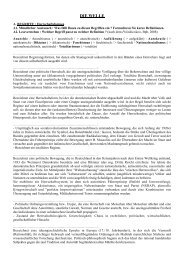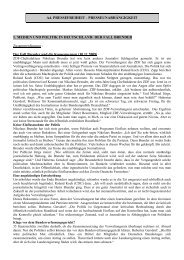Brown v Board of Education Topeka Kansas (1954)
Brown v. Board of Education, Topeka, Kansas (1954)
Brown v. Board of Education, Topeka, Kansas (1954)
- No tags were found...
You also want an ePaper? Increase the reach of your titles
YUMPU automatically turns print PDFs into web optimized ePapers that Google loves.
<strong>Brown</strong> v. <strong>Board</strong> <strong>of</strong> <strong>Education</strong>, <strong>Topeka</strong>, <strong>Kansas</strong> (<strong>1954</strong>)<br />
Key words :<br />
• Supreme court<br />
• Landmark case<br />
• Civil rights movement<br />
• Dissent<br />
• School segregation<br />
• Earl Warren<br />
• Thurgood Marshall<br />
• Separate but equal doctrine,<br />
Plessy v. Ferguson<br />
• 13 th and 14th amendment<br />
• Jim Crow laws<br />
• Civil rights movement<br />
• NAACP<br />
Outline :<br />
1. 14th amendment (1868) : guaranteed equal protection under the law, guaranteed civil<br />
rights but the amendment has been interpreted in contradictory ways—to legislate both<br />
segregation and integration<br />
2. Plessy v. Ferguson (1896): decision that legalized the practices <strong>of</strong> “separate but equal”.<br />
In the Plessy decision, the 14th Amendment was interpreted in such a way that equality<br />
in the law could be met through segregated facilities.<br />
3. Jim Crow laws were passed throughout the South and they established separate<br />
facilities for Blacks and Whites in everything from schools to restrooms, drinking<br />
fountains to witness stands in courtrooms.<br />
4. <strong>Brown</strong> v. <strong>Board</strong> <strong>of</strong> <strong>Education</strong> <strong>of</strong> <strong>Topeka</strong>, <strong>Kansas</strong> (<strong>1954</strong>): This Supreme Court decision<br />
has been credited with much significance. For some, it signaled the start <strong>of</strong> the civil<br />
rights movement <strong>of</strong> the 1950s and 1960s, while for others, it represented the fall <strong>of</strong><br />
segregation. The <strong>Brown</strong> decision established that separate schools were ipso facto<br />
unequal.<br />
I. Discussion:<br />
1. What do you think segregated schools were like in pre-<strong>1954</strong> America?<br />
2. In what parts <strong>of</strong> the country were schools segregated?<br />
3. How was the experience <strong>of</strong> a black student in public school different from that <strong>of</strong> a<br />
white student?<br />
4. Are schools in your country segregated ? In what ways ?<br />
5. What could you do to work against that segregation, bringing more integration to<br />
your school?<br />
6. Do you think that racial segregation in public school hurts the separated races,<br />
assuming the schools are “equal” in terms <strong>of</strong> facilities, class size, teacher pay, etc?<br />
7. Is the harm greater for one race than for the other?<br />
8. Many schools in the USA today are virtually all white or all-minority, even though no<br />
law requires segregation. This is sometimes called “de facto segregation.” Do you<br />
think de facto segregation has a detrimental effect on students?<br />
II. Plessy v. Ferguson - 1896:<br />
http://www.pbs.org/wnet/jimcrow/stories_events_plessy.html<br />
1
On June 7, 1892, 30-year-old Homer Plessy was jailed for sitting in the "White" car <strong>of</strong> the<br />
East Louisiana Railroad. Plessy could easily pass for white but under Louisiana law, he was<br />
considered black despite his light complexion and therefore required to sit in the "Colored"<br />
car. He was a Creole <strong>of</strong> Color, a term used to refer to black persons in New Orleans who<br />
traced some <strong>of</strong> their ancestors to the French, Spanish, and Caribbean settlers <strong>of</strong> Louisiana<br />
before it became part <strong>of</strong> the United States. When Louisiana passed the Separate Car Act,<br />
legally segregating common carriers in 1892, a black civil rights organization decided to<br />
challenge the law in the courts. Plessy deliberately sat in the white section and identified<br />
himself as black. He was arrested and the case went all the way to the United States<br />
Supreme Court. Plessy's lawyer argued that the Separate Car Act violated the Thirteenth<br />
and Fourteenth Amendments to the Constitution. In 1896, the Supreme Court <strong>of</strong> the<br />
United States heard the case and held the Louisiana segregation statute constitutional.<br />
Speaking for a seven-man majority, Justice Henry <strong>Brown</strong> wrote:<br />
"A statute which implies merely a legal distinction between the white and colored<br />
races -- has no tendency to destroy the legal equality <strong>of</strong> the two races. ... The object<br />
<strong>of</strong> the Fourteenth Amendment was undoubtedly to enforce the absolute equality <strong>of</strong><br />
the two races before the law, but in the nature <strong>of</strong> things it could not have been<br />
intended to abolish distinctions based upon color, or to enforce social, as<br />
distinguished from political equality, or a commingling <strong>of</strong> the two races upon terms<br />
unsatisfactory to either."<br />
Justice John Harlan, the lone dissenter, saw the horrific consequences <strong>of</strong> the decision.<br />
"Our Constitution is color-blind, and neither knows nor tolerates classes among<br />
citizens. In respect <strong>of</strong> civil rights, all citizens are equal before the law. ... The present<br />
decision, it may well be apprehended, will not only stimulate aggressions, more or<br />
less brutal and irritating, upon the admitted rights <strong>of</strong> colored citizens, but will<br />
encourage the belief that it is possible, by means <strong>of</strong> state enactments, to defeat the<br />
beneficent purposes which the people <strong>of</strong> the United States had in view when they<br />
adopted the recent amendments <strong>of</strong> the Constitution."<br />
The Plessy decision set the precedent that "separate" facilities for blacks and whites were<br />
constitutional as long as they were "equal." The "separate but equal" doctrine was quickly<br />
extended to cover many areas <strong>of</strong> public life, such as restaurants, theaters, restrooms, and<br />
public schools. The doctrine was a fiction, as facilities for blacks were always inferior to<br />
those for whites. Not until <strong>1954</strong>, in the equally important <strong>Brown</strong> v. <strong>Board</strong> <strong>of</strong> <strong>Education</strong> <strong>of</strong><br />
<strong>Topeka</strong>, would the "separate but equal" doctrine be struck down.<br />
• Translate into French:<br />
Plessy could easily pass for white but under Louisiana law, he was considered black<br />
despite his light complexion and therefore required to sit in the "Colored" car.<br />
• Match the words in bold with the definitions below:<br />
a. the person who disagrees with a majority decision:<br />
b. its Equal Protection Clause requires each state to provide equal protection<br />
under the law to all people:<br />
c. to dispute the constitutionality <strong>of</strong> a law:<br />
d. to establish a rule for subsequent similar cases<br />
e. on purpose:<br />
f. declared the law illegal :<br />
g. it <strong>of</strong>ficially abolished slavery:<br />
h. confirmed the constitutionality <strong>of</strong> the written law:<br />
i. laws passed by a state<br />
j. racial policy by which blacks may be segregated if they are granted equal<br />
facilities in education, transportation, etc…<br />
2
III. Listening:<br />
http://www.npr.org/templates/story/story.php?storyId=1537409<br />
NPR, The Supreme Court and '<strong>Brown</strong> v. <strong>Board</strong> <strong>of</strong> Ed.', by Nina Totenberg. Dec 3, 2004<br />
50 years ago today, the US Supreme Court heard arguments in what would become<br />
perhaps the ______________ Supreme Court decision <strong>of</strong> the 20 th century. Before the justices<br />
on Dec. 8 th , 1953, were ___________ school desegregation cases. The lead <strong>of</strong>f case bore the<br />
name <strong>Brown</strong> v. <strong>Board</strong> <strong>of</strong> <strong>Education</strong> <strong>of</strong> <strong>Topeka</strong>, <strong>Kansas</strong>.<br />
With its companion cases, <strong>Brown</strong> would reverse the course <strong>of</strong> legal history for civil rights.<br />
Today NPR begins a series <strong>of</strong> reports, that over the coming month will examine this decision<br />
and how, half a century later, the nation continues to struggle with ___________ <strong>of</strong> race and<br />
education. We begin this week with NPR legal affairs correspondent, Nina Totenberg, and a<br />
3 part examination <strong>of</strong> the inner workings <strong>of</strong> the Supreme Court as the ______________ made<br />
their decision.<br />
Almost from the moment the civil war ended and Congress ___________ the 14 th<br />
Amendment _____________ racial equality, the Supreme Court began backtracking. Just<br />
how much equality were the newly freed slaves _____________ to? By 1896, the Court, in a<br />
case called Plessy v Ferguson, had ______________ the concept <strong>of</strong> racial segregation.<br />
Separate but equal _______________ the court said, met the 14 th Amendment’s demand for<br />
equal protection <strong>of</strong> the law. In case after _________________ case however, the Court was<br />
willing to tolerate facilities that anyone could see were unequal. By the 1930s, African<br />
Americans had had enough. And the _________________ set out to fulfill the 14 th<br />
Amendment __________________. The civil rights organization set its sight on the public<br />
schools. In the beginning the __________________ was to graduate schools, and in<br />
_________________, the Supreme Court _______________ that the State <strong>of</strong> Missouri had to<br />
admit a black student to its white Law School because there was no state law school for<br />
blacks. In 1950, the court ruled that Texas had to admit blacks to the State all white Law<br />
school because the black school did not have a comparable library, ______________ or<br />
prestige. And in a case from Oklahoma, where the court had ordered the admission <strong>of</strong> a<br />
black student into the Law School, the Court said that blacks could not be segregated in the<br />
classroom, the ______________ and the cafeteria. The man orchestrating the legal<br />
_________________ for the NAACP was Thurgood Marshall, the son <strong>of</strong> a railroad dining car<br />
waiter and a schoolteacher. Raised in segregated Baltimore, Marshall assembled a legal<br />
____________ <strong>of</strong> black and white ______________ for the _______________ on segregation.<br />
Many on the team would later become _____________ themselves, Marshall would become<br />
the nation’s first black Supreme Court ______________, but in these crucial years, Marshall<br />
was an outsider and a legal ___________________.<br />
• Find in the text the words and expression that mean in French:<br />
a. Une decision historique<br />
b. Les rouages<br />
c. Faire marche arrière<br />
d. Nouvellement libres, libérés<br />
e. Satisfaire une exigence<br />
f. Ils en ont eu assez<br />
g. Le personnel enseignant<br />
IV. Video:<br />
3
http://www.youtube.com/watch?v=TTGHLdr-iak<br />
1. By the early 1950s, segregation was<br />
a. stronger<br />
b. weaker<br />
c. universal<br />
d. illegal<br />
2. In the early 1950s, schools were<br />
a. desegregated<br />
b. mostly segregated<br />
c. not an issue in the racial debate<br />
d. not accessible to black children<br />
3. Southerners were afraid that desegregation would cause<br />
a. mixed marriages<br />
b. the closing <strong>of</strong> schools<br />
c. too much dating<br />
d. a political revolution<br />
4. Thurgood Marshall was a<br />
a. lawyer for the NAACP<br />
b. judge in the <strong>Brown</strong> case<br />
c. black student denied access to a white school<br />
d. Supreme Court justice<br />
5. <strong>Brown</strong> v. <strong>Board</strong> <strong>of</strong> <strong>Education</strong> is in fact a consolidation <strong>of</strong> _____ cases.<br />
a. 2<br />
b. 3<br />
c. 4<br />
d. 5<br />
6. John W. Davis was<br />
a. a NAACP lawyer<br />
b. the lawyer defending the <strong>Board</strong> <strong>of</strong> <strong>Education</strong><br />
c. the president <strong>of</strong> the USA<br />
d. an adversary to racial segregation<br />
7. The ‘separate but equal’ doctrine states that<br />
a. there is no inherent equality between black and white<br />
b. separate facilities are legal as long as they are “equal”<br />
c. no state can decide on the matter <strong>of</strong> segregation<br />
d. segregation is illegal because all citizens are equal under the law<br />
8. How many justices are there at the Supreme Court?<br />
a. 6<br />
b. 7<br />
c. 8<br />
d. 9<br />
9. Earl Warren was a<br />
a. a dissenting justice<br />
b. a recent nominee at the Supreme Court<br />
c. a famous black lawyer<br />
d. a student in <strong>Topeka</strong>, <strong>Kansas</strong><br />
10. This is an extract from the Supreme Court opinion, please fill in the blanks:<br />
We conclude that, in the field <strong>of</strong> public education, the doctrine <strong>of</strong> "_______________<br />
but equal" has no place. Separate educational ___________________ are inherently<br />
unequal. Therefore, we __________________ hold that the ______________ are<br />
4
deprived <strong>of</strong> the equal protection <strong>of</strong> the laws _____________ by the<br />
___________________ Amendment.<br />
11. Robert L Carter was<br />
a. a black student<br />
b. a Supreme Court Justice<br />
c. the plaintiff’s lawyer<br />
d. the defense lawyer<br />
12. Vernon Jordan explains that, after the decision, he<br />
a. received a new geometry book and a new tuba<br />
b. could apply to any school he chose<br />
c. could no longer play in the high school band<br />
d. had to go to Georgia Tech<br />
He says: “In 1951, I had used plain geometry books that had been used by white students<br />
in 1935. <strong>Brown</strong> said that that was over. The hand me down tubas that I played in the high<br />
school band from the white high schools; it said to me that that was ended. And it said to<br />
me that at some point, I would not have to travel from Atlanta to Greencastle, Indiana to get<br />
an undergraduate degree, that my family, my cousins, my neighbors could go to Georgia<br />
Tech or the University <strong>of</strong> Georgia. The Supreme Court decision <strong>of</strong> <strong>1954</strong> was to me the<br />
Magna Carta, it was the second emancipation”.<br />
Magna Carta, 1297: it widely viewed as the most important document in the history<br />
<strong>of</strong> democracy. It guaranteed among other things the right to due process which led<br />
to trial by jury.<br />
V. <strong>Brown</strong> v. <strong>Board</strong> <strong>of</strong> <strong>Education</strong> – <strong>1954</strong>:<br />
http://www.pbs.org/wnet/jimcrow/stories_events_brown.html<br />
On May 17, <strong>1954</strong>, the U.S. Supreme Court ruled unanimously that racial segregation in<br />
public schools violated the Fourteenth Amendment to the Constitution, which says that no<br />
state may deny equal protection <strong>of</strong> the laws to any person within its jurisdiction. The <strong>1954</strong><br />
decision declared that separate educational facilities were inherently unequal. Following a<br />
series <strong>of</strong> Supreme Court cases argued between 1938 and 1950 that chipped away at<br />
legalized segregation, <strong>Brown</strong> v. <strong>Board</strong> <strong>of</strong> <strong>Education</strong> reversed an earlier Supreme Court<br />
ruling (Plessy v. Ferguson, 1896) that permitted "separate but equal" public facilities. The<br />
<strong>1954</strong> decision was limited to the public schools, but it was believed to imply that<br />
segregation was not permissible in other public facilities. The key phrase in the ruling<br />
delivered by Chief Justice Earl Warren was as follows:<br />
"Segregation <strong>of</strong> white and colored children in public schools has a detrimental effect<br />
upon the colored children. The impact is greater when it has the sanction <strong>of</strong> the law,<br />
for the policy <strong>of</strong> separating the races is usually interpreted as denoting the inferiority<br />
<strong>of</strong> the Negro group. A sense <strong>of</strong> inferiority affects the motivation <strong>of</strong> a child to learn.<br />
Segregation with the sanction <strong>of</strong> law, therefore, has a tendency to [retard] the<br />
educational and mental development <strong>of</strong> Negro children and to deprive them <strong>of</strong> some<br />
<strong>of</strong> the benefits they would receive in a racially integrated school system. ... We<br />
conclude that, in the field <strong>of</strong> public education, the doctrine <strong>of</strong> "separate but equal"<br />
has no place. Separate educational facilities are inherently unequal."<br />
<strong>Brown</strong> v. <strong>Board</strong> received its name from the lawsuit brought by the parents <strong>of</strong> eight-year-old<br />
Linda <strong>Brown</strong>, who had to travel a great distance to attend grade school while white children<br />
went to a school a few blocks away. The NAACP brought suit on behalf <strong>of</strong> her parents to<br />
admit her to her neighborhood school. The <strong>Brown</strong> case was one <strong>of</strong> a total <strong>of</strong> five cases<br />
charging that segregation in education was a violation <strong>of</strong> the equal protection <strong>of</strong> the laws<br />
clause <strong>of</strong> the Fourteenth Amendment. They included Briggs v. Elliot at al. (South Carolina)<br />
Davis at al. V. County School <strong>Board</strong> <strong>of</strong> Prince Edward County (Virginia); Gebhart et al. V.<br />
Benton (Delaware), and Bolling v. Sharpe (District <strong>of</strong> Columbia). Four <strong>of</strong> the cases were<br />
5
ought by the National Association For the Advancement <strong>of</strong> Colored People (NAACP) and<br />
were argued before the Supreme Court by Thurgood Marshall. Marshall would later become<br />
the first black justice on the Supreme Court.<br />
• Translate into French:<br />
<strong>Brown</strong> v. <strong>Board</strong> received its name from the lawsuit brought by the parents <strong>of</strong> eight-yearold<br />
Linda <strong>Brown</strong>, who had to travel a great distance to attend grade school while white<br />
children went to a school a few blocks away. The NAACP brought suit on behalf <strong>of</strong> her<br />
parents to admit her to her neighborhood school.<br />
• Translate into French:<br />
a. <strong>Education</strong>al facilities<br />
b. Therefore<br />
c. A justice<br />
• Match the words in bold with the definitions below:<br />
a. to refuse<br />
b. to decide judicially<br />
c. alleging<br />
d. gradually made it less effective<br />
e. a legal action<br />
f. in essence<br />
g. brought an action<br />
h. in the interest <strong>of</strong><br />
VI. Segregation Today : 55 years after <strong>Brown</strong> v. <strong>Board</strong> <strong>of</strong> <strong>Education</strong><br />
• Listen to the recording and fill in the blanks:<br />
De Facto School Segregation Growing, Study Says. WBUR, January 24, 2006.<br />
http://www.wbur.org/npr/5169990/de-facto-school-segregation-growing-study-says<br />
ED GORDON, host: From NPR News, this is NEW AND NOTES. I'm Ed Gordon,<br />
1. A recent Associated Press Ipsos Poll found that 78 ________________ <strong>of</strong> white Americans<br />
and 66 percent <strong>of</strong> black Americans agree we're _____________ than ever to Dr. King's dream<br />
<strong>of</strong> racial equality. But a new study ________________ by Harvard University's Civil Rights<br />
Project suggests, when it comes to public education, we still have a ways to go. America's<br />
schools are more segregated than they were _________ years ago, and some districts are so<br />
segregated, that they have what the study calls ______________ schools. For more on that<br />
report, I sat down with Gary Orfield, pr<strong>of</strong>essor <strong>of</strong> education and director <strong>of</strong> Harvard's Civil<br />
Rights Project, and John Brittain, chief counsel and senior deputy for the Lawyers'<br />
________________ for Civil Rights Under Law.<br />
2. Mr. Brittain says, our judicial system ____________ credit for ordering desegregation in its<br />
_______________ <strong>1954</strong> <strong>Brown</strong> v. <strong>Board</strong> decision, but also blamed for failing to keep the<br />
_________________ <strong>of</strong> that ruling today.<br />
3. Mr. JOHN BRITTAIN (Chief Counsel and Senior Deputy, Lawyers' Committee for Civil<br />
Rights Under Law): I don't think we went wrong. I think the court __________ the door to<br />
school integration. They've become much more ________________; they require intent; they<br />
impose large burdens; and the federal government, particularly the Department <strong>of</strong><br />
<strong>Education</strong>, that once was a _________________ <strong>of</strong> school integration, how now<br />
6
__________________ the effort. Furthermore, to let school districts build schools in black and<br />
Latino neighborhoods _______________ segregation with state full funding and they let<br />
predominantly white schools renovate and build new schools in the suburbs that also<br />
maintains desegregation. So, our laws have failed and our ___________________ actors have<br />
failed.<br />
4. Mr. GARY ORFIELD (Pr<strong>of</strong>essor <strong>of</strong> <strong>Education</strong> and Director <strong>of</strong> Civil Rights Project, Harvard<br />
University): You also see that this line has been _______________ between city and suburb,<br />
as if we were two different civilizations. Once you get an overwhelmingly minority city, the<br />
Supreme Court basically says you can't do anything about the problem ____________ you<br />
can find the state constitutional right or something like that, even though it would be a very<br />
feasible and ___________ solution.<br />
5. GORDON: What <strong>of</strong> those who will suggest, Pr<strong>of</strong>essor, that it's simply a failed experiment<br />
to force people to go to school together was the mistake that we really should have<br />
_____________ for, even if it were separate but equal, a sheer equation that gave equal<br />
dollars to equal systems.<br />
6. Pr<strong>of</strong>essor ORFIELD: So far as I can tell, there's no school district that's ever ____________<br />
separate but equal schools on any significant __________; and that's because, as our<br />
____________ shows, in more than three-quarters <strong>of</strong> the cases, segregated minority schools<br />
have concentrated ____________. Putting money into those schools without changing<br />
_____________, without changing teachers, without changing _______________, without<br />
changing levels <strong>of</strong> competition, connections to college and so forth, just doesn't make them<br />
equal. You could put money into your local community college, a lot <strong>of</strong> it, and it wouldn't be<br />
Harvard, because you wouldn't have the students and the faculty, the connections, the<br />
______________, and so forth.<br />
7. Everyone who is in favor <strong>of</strong> school integration, is also in favor <strong>of</strong> trying to do everything<br />
possible to equalize city schools, so far as I know; and they're not contrary things. They<br />
both need to be done because there's no desegregation ____________ that's going to<br />
accomplish everything in any short period <strong>of</strong> time. Separate but equal isn't really possible<br />
on any scale in a society where almost everything is related to race in quite powerful ways.<br />
• Please find in the script the words or expressions that mean the same as:<br />
a. A lot <strong>of</strong> work to do or improvements to make (paragraph 1)<br />
b. To be owed recognition for doing something (2)<br />
c. To find fault with (2)<br />
d. A person who defends a cause (3)<br />
e. To give up (3)<br />
f. Capable <strong>of</strong> being done, accomplished (4)<br />
g. Individual facts, statistics, items <strong>of</strong> information (6)<br />
7


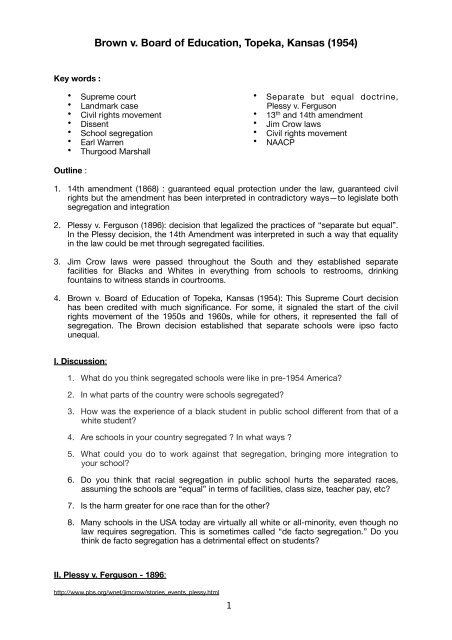
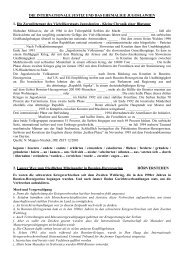

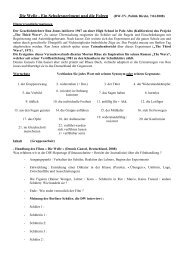

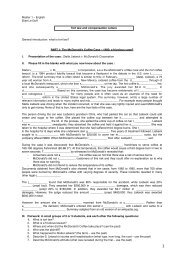

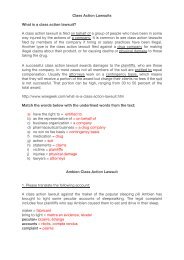
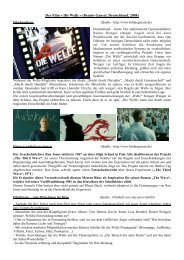


![DAS BUNDESVERFASSUNGSGERICHT [BVG] – ÜBUNGEN A ...](https://img.yumpu.com/21092838/1/184x260/das-bundesverfassungsgericht-bvg-ubungen-a-.jpg?quality=85)
